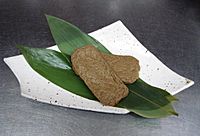Satsuma-age facts for kids
Satsuma-age (薩摩揚げ) is a tasty fried fishcake that comes from Kagoshima, Japan. It's made by mixing a special fish paste called surimi with flour. This mix is then fried until it becomes solid and delicious. Satsuma-age is a famous food from the Satsuma area and has many different names across Japan.
The fish paste is seasoned with salt, sugar, and other spices. It can be shaped in many ways. While it's mostly made from ground fish, it can also include other ingredients like wood ear mushrooms, beni shōga (red ginger), onions, or other vegetables. Sometimes, seafood like squid, octopus, or shrimp are added too. In fishing towns, people often make it from local fish like sardines, shark, bonito, or mackerel. It's common to mix two or more kinds of fish together.
People enjoy Satsuma-age in many ways. You can eat it plain, or lightly roasted. It's often dipped in ginger and soy sauce, or mustard and soy sauce. It's also a popular ingredient in other Japanese dishes like oden (a type of stew), udon noodles, sara udon (crispy noodles), or nimono (stewed dishes).
Contents
What is Satsuma-age Made From?
Satsuma-age often used to be made with cod. However, because cod fish are not as common now, other types of white fish are used instead. These can include fish like haddock or whiting. Sometimes, oily fish like salmon are used, which gives Satsuma-age a very different flavor.
The special fish paste called surimi (which means "ground meat" in Japanese) can be made from many different kinds of fish. Some common ones are:
- Alaska pollock
- Lizardfish
- White croaker
- Daggertooth pike conger
- Japanese Spanish mackerel
- Flying fish
- Different kinds of sardines
- Different kinds of sharks
- Skipjack tuna
- Different kinds of mackerels
- Okhotsk atka mackerel
- Tilapia
- Black bass
The History of Satsuma-age
There are a few stories about where Satsuma-age first came from. The most well-known story says it started in the Satsuma area of Kagoshima. It's believed that around 1864, the Shimazu clan brought this fried fish paste to Satsuma from Okinawa. In Okinawa, this dish was called "chigiage." After it arrived in Kagoshima, it became known as "tsukiage" and was even chosen as one of the top 100 local dishes.
Different Names for Satsuma-age
This delicious dish is known by different names depending on where you are in Japan.
- In the Tōhoku region and Kantō region, it's called "Satsuma-age," named after its origin in Kagoshima.
- In the Chūbu region, it's known as "Hanpen."
- In Hokkaidō and western Japan, people call it "Tempura." This is different from the well-known Tempura dish of fried vegetables and seafood.
- In Kyūshū and Okinawa, it's often called "Tempura," "Tsukeage," or "Chikiagi."
Types of Satsuma-age
There are many fun varieties of Satsuma-age:
- Hiraten: This is a flat type of Satsuma-age.
- Maruten: This Satsuma-age is shaped like a thin disk. People in Kyūshū, especially Fukuoka, often eat it with udon noodles.
- Gobouten: This type has a stick of burdock root wrapped inside the fish paste.
- Ikaten: This one has squid tentacles wrapped inside.
- Takoten: This variety has pieces of octopus wrapped inside. Some are even shaped like little balls, similar to takoyaki.
- Tamanegiten: This type includes onion in the mix.
- Bakudan: This fun name means 'Bomb'! It's a Satsuma-age that has a whole boiled egg wrapped inside.
- Honeku or honeten: These are shorter versions of "honekuri-tempura." They are a local dish from northern Wakayama Prefecture. They are made by grinding whole cutlass fish and then frying them. They have a unique smell.
- Jakoten: This is a special product from Uwajima in southern Ehime Prefecture. Jakoten has a long history, going back to the Edo period. It's made from small local fish that are blended into a paste and then fried.
- Gansu: This is a local dish from Hiroshima. It's a fried patty made from breaded ground whitefish, similar to a cutlet.
Satsuma-age Around the World
Satsuma-age has also become popular in other countries:
- In Korea, Satsuma-age is called eomuk or simply odeng. In big cities like Busan and Seoul, you can find these sold as street food, especially in winter and fall.
- In Taiwan, Satsuma-age is sold as tianbula. This name comes from the Japanese word tempura, which is what Satsuma-age is often called in Kyushu. It's a common ingredient in dishes like oden, hot pot, and lu wei.
- Similar fried fish dishes can also be found in Vietnam.
See also
 In Spanish: Satsuma age para niños
In Spanish: Satsuma age para niños


